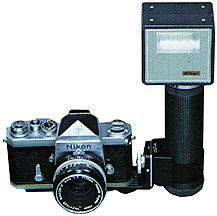Now you can synchronize
flash and body by attaching the SC-5. For those of you with a choice, the PC plug
should go into the "X" terminal, rather than the "M". Then, you
can hook up the appropriate power source. Note that the SN-1 goes into the bottom
of the handle, while the SD-3's cord attaches to the ringlight socket, and the SA-1
and SD-2 both attach to the square four-connector port on the left side of the flash
head. The SA-1 serves as a charger for the SN-1, which requires 7-8 hours of charging
after 40 flashes, or 14-16 hours after 80 flashes. The SH-1 charges the SN-1 much
more quickly, only 3 hours after 40 flashes. You can also hook up the appropriate
eyepiece pilot lamp, via SC-4 (F2) or SF-1 (F, Nikkormats), at this point, and have
wires dangling from virtually every port of the SB-1. If that's not enough, and you
manage to dig up more SB-1's, you can connect up to two more for multiple flash,
as well as their various power accessories (although, thankfully, you only have to
sync the first one; the SE-2 connects the sync socket on the left side of the flash
head to the regular sync connection on the bottom of the next flash).
Exposure calculation is
relatively straightforward, thankfully. The SB-1 is a manual flash with one output
setting -- full blast -- so you only need to know how to work the calculator dial.
Align the proper ASA number with the appropriate mark (color or black and white film);
you will then be able to read the guide number for the film speed selected. Alternatively,
determine your focus distance (compose, focus on the subject you'd like to expose,
and transfer the indicated distance to the calculator dial) which will line up opposite
the aperture you need to set. Based on this aperture, you may select a shutter speed
at sync or slower to properly expose the background. On the other hand, if you don't
want your subject to have the deer-caught-in-the-headlights look, rate your film
somewhat faster than normal -- and now you're doing fill-flash with thirty-year-old
equipment. Yes, it's not 3D Matrix-Balanced (tm) but you've done most of what automation
has taken over -- determined distance, trimmed light output, etc. Of course, if you
really want to be serious about it, you should have the NPC ProBack on, take a couple
of test Polaroids, move the flash far off-camera ...



